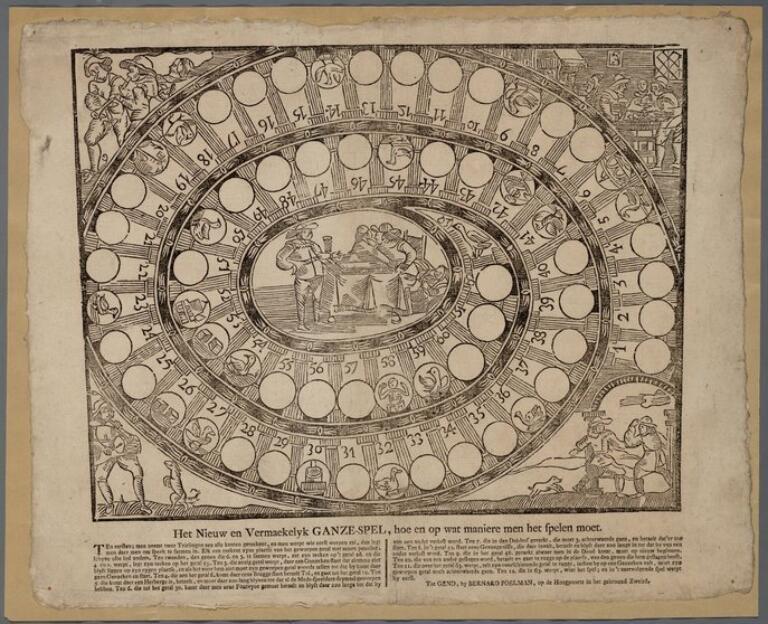The Oldest Game of the Goose

Rules of the Game of the Goose
Ready to play?
Great! Read all the rules carefully before you start.
- Decide in advance what’s at stake (candy, tokens, money…).
- Ask for the dice at the reception. Is the museum closed? Use an online dice roller. Be sure to select two dice.
- All players start at the starting square. The youngest player goes first.
- Roll the dice and move forward the number of spaces shown.

Rules of the game
If you land on one of these squares, bad luck!
- Square 6 – The Bridge: Pay the stake, or pay double and move directly to square 12.
- Square 19 – The Inn: Pay the stake and skip your turn.
- Square 31 – The Well: Pay the stake and wait until another player lands on the same square to free you. Or pay double the stake and move on the next turn.
- Square 42 – The Maze: Pay the stake and move back 3 spaces.
- Square 52 – The Prison: Pay the stake and wait until another player lands on the same square to free you.
- Square 58 – Death: Pay three times the stake and start over from the beginning.
If you land on these squares, you're in luck!
For the first roll, these rules apply:
- If you roll a 3 and a 6, move directly to square 26.
- If you roll a 4 and a 5, move directly to square 53.
Optional Rule: You can also play by allowing players who land on square 26 or 53 to roll again!
On certain squares, these rules apply:
- Squares where the digits add up to 5 or 9: If you land on one of these squares 5, 14, 23, 32, 41, 50, 59, 9, 18, 27, 36, 45, or 54, you get to roll again and move forward the same number as your last roll.
The first player to reach square 63 wins the game!
The Oldest Flemish Game of the Goose
Discover a rare piece of history: the oldest Goose Game in Flanders
This exceptional game, on loan from the Hendrik Conscience Heritage Library in Antwerp, was engraved in the mid-17th century by Johannes Christofel Jegher. Due to its fragility, the game board will be on display at the museum for only three months before returning to the Hendrik Conscience Library for optimal preservation.

A timeless game with a rich history
The Goose Game became famous in the 16th century thanks to Francesco de Medici, who gifted a copy to Philip II of Spain. It quickly spread across Europe.
This game is more than just a dice game: it represents the journey of life, where luck and misfortune alternate. The dice determine your fate, and you must overcome obstacles like the bridge, the prison, and the maze.
The game consists of 63 spaces, a number that is no coincidence: it is the product of 7 and 9, numbers considered to be magical and lucky. The spiral design symbolizes infinity.
Since the 17th century, the Game of the Goose has been an integral part of our play culture. This hand-colored example from the Hendrik Conscience Library is being displayed for the first time at the Toy Museum of Mechelen.
The wooden block used to print this engraving was made in the mid-17th century by Johannes Christofel Jegher. This is also evident in the clothing of the figures.
The engraving includes the text:
"t' Antwerpen by de weduwe van Hieronymus Verdussen op de Groote Merckt in S. Augustinus."
Hieronymus Verdussen passed away in 1713, and his son took over the printing business in 1717. This print was therefore made between 1713 and 1717, but with a woodblock dating back to 1650. It was not uncommon for old blocks to be reused across generations.
This game board was glued into a book called “Het boeck Poperye”, a collection of prints from the 17th to the 19th century. In the 19th century, it underwent a unique transformation: 18th-century coin prints were pasted onto it, along with a poem:
"Die met speelen veel wilt winnen moet dit swaentiens spel beginnen / Want de croonen syn ter hand die men stelt tot onderpand."
This Goose Game is a beautiful testament to Flemish printing traditions and the cultural impact of the game through the centuries.
Variants
Jegher’s game inspired many variations. One of them, an 18th-century Ghent version, comes from the Huis van Alijn collection and is displayed alongside the oldest game board at the Toy Museum of Mechelen.
A version of the "Nieuw en vermaekelyk ganze-spel" was printed in the late 18th century by the Ghent printer Bernard Poelman, who published both religious texts and… Goose Games! This rectangular board features a spiral of 63 spaces, separated by small columns.
On square 63, you see a man being thrown out of a building by a woman wielding tongs. Above the door, a goose plays the trumpet.
At the center of the spiral, a famous scene unfolds: on the left, a man plays backgammon while a woman distracts his attention, allowing another man to steal his money. You’ll also spot players, musicians, and… a dancing dog!

Activities


